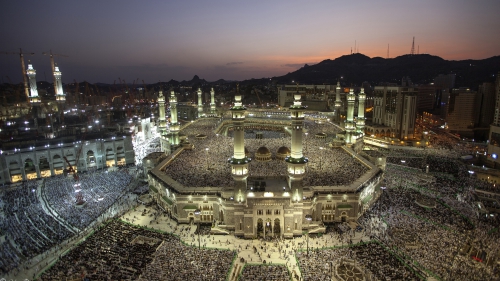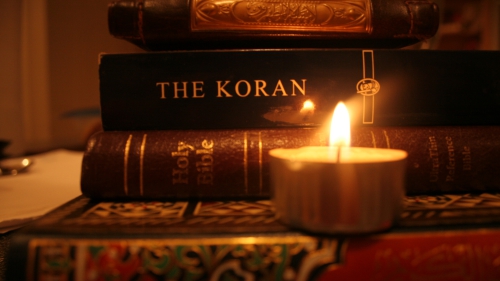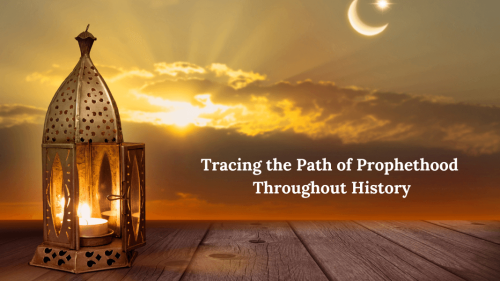Inter-Religious Marriage And Islam
In this article I wish to discuss the objections usually raised against the idea of inter-religious marriage. The prohibition against inter-religious marriage is dinned into our ears from childhood with the result that the idea sounds to most of us as almost unthinkable. When such marriages occasionally do take place they are looked upon as unfortunate social accidents and generate a lot of tension or resentment within the concerned families and also society in general. Such marriages are not tolerated but merely endured by the family. One frequently hears of parents disowning their son or daughter. Both Hindus and Muslims reject the idea of inter-marriage on grounds, which are religious as well as social psychological or cultural. I shall deal with these grounds separately. As far as religious objections go I, as a Muslim, shall confine myself to Islam only.
(i)
The Islamic canon law (shariah) prohibits inter-religious marriage but allows a Muslim male to marry a Jewish or Christian woman. This position is based upon the following two verses of the Quran: (The English version is from Picthall’s well known translation of the Quran).
(Quran, 2:221)
“Wed not idolatresses till they believe; for lo! A believing bondwoman is better than an idolatress though she please you; and give not your daughters in marriage to idolaters till they believe, for lo! A believing slave is better than an idolater though he please you. These invite unto the Fire, and Allah inviteth unto the Garden, and unto forgiveness by His grace, and expoundeth thus His revelations to mankind that haply they may remember.”
(Quran 5:5)
“This day are (all) good things made lawful for you. The food of those who have received the Scripture is lawful for you, and your food is lawful for them. And so are the virtuous women of the believers and the virtuous women of those who received the Scripture before you (lawful for you) when ye give them their marriage portions and live with them in honor, not in fornication, nor taking them as secret concubines. Whoso denieth the faith, his work is vain and he will be among the losers in the Hereafter.”
I shall first deal with verse 5:5. This verse provides the textual basis for the Muslim canon law, which allows inter-marriage between Muslim men and Jewish or Christian women, but prohibits Muslim women from marrying Jews or Christians. Two comments are called for. First, the Quranic text does not specify the identity of ‘those who have received the Scripture before you’ (the Muslims). Second, the basic mood, which pervades the verse, is one of reciprocal symmetrical liberalism with regard to the food and virtuous women of both Muslims, and those who have received the Scripture earlier. The emphasis of the text is upon virtuously living together in proclaimed wedlock rather than in maintaining clandestine relations between the sexes, irrespective of their religion. Now the traditional interpretation of the Qurainc verse does two rather unwarranted things, which erode the basic liberal humanistic thrust of the Quranic text. First, it confines the expression ‘people of the book’ or ‘those who have been given the Scripture before you’ to Jews and Christians alone. Second, it confines the permissibility of inter-marriage to the marriage of Muslim men with Jewish or Christian women. This interpretation will not stand in the light of careful analysis of the letter and the spirit of the Quran itself.
The Quran expressly declares repeatedly that God’s messengers and prophets have been sent in every age and region of the world to guide mankind. If so, the people of, say, India and China, are as much the people of the book as the people of Palestine. Why then should their women be excluded from marrying Muslim men? Second, the one-sided permission of Muslim men to marry Jewish or Christian women does not make sense. Muslim commentators and jurists defend this asymmetrical permission of inter-religious marriage on the ground that the male partner will dominate the upbringing of the children who will automatically become Muslims. But this reasoning assumes that the influence of the father upon the progeny is invariably greater than that of the mother. This assumption is, however, not borne out by actual experience. Quite often the mother plays a more dominant and inspiring role in the education and training of her progeny. It is, therefore, a facile view that the spiritual health of the family will remain satisfactory if a Muslim male is married to a non-Muslim but not if a Muslim women is married to a non-Muslim. In the final analysis, the character and integrity of the spouses and their temperamental compatibility, quite irrespective of their professed religions, will determine the spiritual and material well being of the family.
Let us now turn to the Quranic verse, 2:221. The prohibition of marriage in this verse applies symmetrically to idolaters and idolatresses. According to the traditional Islamic approach the prohibition applies to an entire group labeled as ‘idolaters’ or ‘polytheists’ rather than to individuals on the basis of their actual beliefs and practice. This approach, however, ignores the crucial fact that it is always a person or individual who practices idolatry or abstains from it, the group having no existence apart from the individuals composing it. In other words, the proper object of the judgment in question or the proper referent of the Quranic prohibition ought to be individuals rather than an entire group as such.
Moreover, and this consideration is equally crucial, every large religious group always comprises sub-groups or sects based upon internal distinctions or differences of various kinds. As a result of these internal distinctions any blanket dichotomous classification of the members of the group becomes extremely misleading. For instance, Hindus who belong to the Brahmo Samaj and Arya Samaj reject idolatry as much and as categorically as the Muslims themselves. The same applies to the Sikhs. Why, then, should they be subject to the Quranic prohibition on marriage of Muslims and idolaters? Again, numerous individual Hindus repudiate idolatry both in theory and practice, though they do not object if their co-religionists wish to practice it. In other words, it does not stand to reason to hold the entire Hindu community or group to be idolaters.
In the light of the above analysis it appears that the correct or valid interpretation of the Quranic text would be that a Muslim should not marry such Hindus who are idolaters. Now this is a very different proposition from placing a total and unconditional ban upon inter-marriage between members of the different religious groups. To put the matter more directly, the deciding factor for attracting the clear Quranic prohibition should be the actual faith and practice of the parties to the marriage rather than any blanket judgment on the community as a whole. Let me try to explain my point by giving a hypothetical example.
Suppose the Quran had prohibited Muslims from marrying a liar without specifying any other details. It is pre-eminently reasonable to hold that this prohibition would have applied to individual liars rather than to any particular group based on religion, region or race. Moreover, the proper way to act upon the Quranic injunction would have been actually to investigate whether or not a person is a liar rather than declare any particular religious, racial, regional or occupational group as liars who automatically attract the said Quranic prohibition.
There is another very vital consideration, which would confirm the rightness of the view that the Quranic text must be interpreted, as applicable to individuals rather than a group as a whole. The Quranic verse 5:5 allows inter-marriage between Muslims and the ‘people of the book’, while the verse, 2:221 prohibits Muslims from marrying idolaters and idolatresses. Now, while the Jews are conspicuous for their absolute repudiation of idol worship and their unqualified acceptance of pure monotheism, the same cannot be said of the Christians because of their commitment to the dogma of trinity. Indeed, numerous Islamic theologians honestly believe that the said Christian dogma involves associating others with the one God and that this amounts to polytheism (shirk). If so, the marriage of a Muslim male with a Christian woman (deemed permissible by verse 5:5) would attract the prohibition contained in verse 2:221. Now this would land Muslims in a quandary. The only way to resolve this contradiction is to accept the view that the concerned Quranic verses apply to individuals rather than to groups as a whole. On this interpretation the marriage of a Muslim, whether male or female, would be permissible with a non-Muslim provided he or she is not a polytheist and does not practice idolatry.
Marriage is a contractual relationship between two individuals, according to Islam. If the contractual parties do not stand in the list of prohibited degrees of marriage, as given in the Quranic text, as such, (Quran, 4:22-23) differences in race, religion, caste, and economic status should not stand in the way of their marriage, provided the non-Muslim party has clearly repudiated idol-worship in theory and practice. A Muslim marrying a non-Muslim does not violate any basic tenet of Islam so long as the non-Muslim, as an individual, does not commit himself or herself to idolatry.
The Islamic canon law (shariah) already allows Muslim males to marry Jewish or Christian women. This amounts to accepting, in principle, the idea of inter-religious marriage. This step was a notable, rather a revolutionary, advance made by Islam in the direction of the humanistic concept of marriage as a loving contract between individuals irrespective of their religion. There is nothing wrong for Muslims to develop the nucleus of the humanistic approach to marriage, already found in the Islamic tradition, to its full and logical conclusion.
The above suggestion will not appeal to conservative Muslim opinion. But new interpretations within a tradition, provided they are essentially productive of human welfare, gradually overcome the natural and quite understandable resistance to change. The following is a random but good sample.
Muslim theologians at one time opposed the printing of the Quran and also books in general. The same applied to translating the Quran in different languages. Many Muslim and Catholic theologians are still opposed to family planning. Several Muslim theologians and jurists oppose music, drama, and painting of animal forms on various grounds. The pursuit of free enquiry, the freedom of conscience, and equal rights to women are deemed to be unIslamic by many learned Muslims. Yet profound changes, slowly but steadily, have taken place in different Muslim societies. It is a different matter that the pace of change has been slow to the point of exasperation, if not despair. However, the pace is likely to increase considerably due to the continuing technological revolution, in general, and the communications revolution in particular.
The thought and value systems of Christianity and Hinduism have responded much more positively and vigorously to the requirements and demands of the modern age. But, unfortunately Islam has been left behind in the quest for a suitable reconstruction of its basic concepts and values to meet new challenges posed by the contemporary human situation. Creative Christian and Hindu scholars and savants have projected their religions in a manner that could claim an almost universal appeal. But most Muslim scholars and divines still equate the medieval Islamic paradigm with the essence of the Islamic faith. To them, any creative response in the sphere of Quranic interpretation amounts to the stretching and twisting of the Word of God for the sake of worldly gains or making a better ‘adjustment’ to the anti-Islamic powers of the day. However, I honestly and respectfully submit that the humanistic interpretation of the Quranic texts on the subject of inter-religious marriage is an intrinsically valid insight rather than a mere pragmatic adjustment to the present global society marked by emerging democratic pluralism.
(ii)
Let us now consider the main purely social psychological and cultural objections to inter-marriage.
Perhaps, the most common objection is that children of a mixed marriage are exposed to conflicting religious and moral messages in their formative years due to the opposed beliefs and practices of their parents and wider family members. If both the parents are indifferent to religion than children are spared the evil effects of the divided concerns of their parents, but then they are in the danger of losing all concern for religious and spiritual values altogether. It is further said that religious differences may not prove detrimental in the early years of marriage. But with the passage of time the mischief begins unless one of the spouses subordinates him or herself to the other. The argument goes on to say that while a lot of adjustment is needed in every marriage (even when the couple profess the same religion) the degree and type of adjustment required in an inter-religious marriage become forbidding.
I shall first deal with the social psychological argument and then come to the cultural side of the issue of inter-marriage. It is true that the possession of a common or similar religious background is very helpful in promoting family harmony. But having a common or similar cultural and economic background is no less important. However, the single most important pre-condition of a happy and harmonious family life is temperamental and sexual compatibility of the spouses. In the absence of this compatibility a common religion will be of little avail.
The objection that the clash of religious rituals, ceremonies and festivals prevents the couple from sharing their religious life does not hold good. Sympathetic participation in each other’s religious or spiritual world is quite possible even without a common commitment. This type of loving and active sympathy indeed, gives immense joy and elevates the human spirit. To give a personal instance, I once happened to travel in the same railway compartment as a distinguished Hindu lawyer of Aligarh. He was known to be an atheist in his circle of friends. As soon as the train reached the Ramganga Bridge, near Bareilly, my friend took out some coins, placed them in the hands of his wife and then threw them into the river below in the orthodox Hindu fashion. Soon afterwards the atheist lawyer gently explained to me that he had done so solely out of respect for his wife and that he himself did not at all approve of this form of venerating river goddesses.
The sympathetic understanding of the faith of another deepens one’s own religious faith and promotes the oneness of the human family. True understanding does not necessarily lead to actual commitment. But it enables one to pass from the outer ritual or symbol to the inner core of the faith and to see the world as it appears to the believer. The sympathetic understanding of different faiths does not necessarily waken one’s own and does not necessarily make one indifferent to religion. Genuine and sincere communication based on mutual respect actually nourishes one’s own faith, to the extent that it is genuine and meets with the inner approval of a mind, which has freed itself from the invisible chains of dogma and the fear of society. The awareness of other religions and communication with their believers dissipates one’s own faith only to the extent that it is sheer imitation or cultural conditioning without authentic commitment. That is why it sometimes happens that a superficial verbalization of one’s own creed (instilled in early childhood) becomes a deep and living creed, for the first time, only when we come under the influence of a really elevated soul though his formal religion differs from our own.
I shall now examine the view that religious faith cannot flourish in adult life unless parents and teachers inculcate it in the childhood or early youth. Though it is a fact that a religious creed is learnt by the child as he learns the language, manners, morals and music of his group he can grasp the thought and value system concerned, if at all, only when he reaches adulthood. In the final analysis, religion is the depth response of a mature individual to the mystery of man in the universe. Parents can only indoctrinate the child; they cannot lead the child to experience the basic religious feeling of awe and wonder when man contemplates the inscrutable mystery of the universe. Now many psychologists and teachers who are themselves deeply religious souls have come to the conclusion that giving the child objective and sympathetic acquaintance with the major religious traditions of the human family (with special emphasis upon one’s own cherished tradition) gives a better religious foundation to the child than sheer indoctrination into a single religious creed. Indeed, some of the most eminent Christian thinkers of our times hold that children should be taught only basic morality, and theology or dogma should wait the advent of maturity. Even more important than the verbal inculcation of moral values is the actual example set by the words and deeds of the role models accepted by the child. Since religions differ primarily in their theology rather than in their ethics parents professing different religions should have no problem in teaching basic moral principles to the children.
The best way of inculcating moral and spiritual values in the children is to relate to them stories or anecdotes that bring out the meaning of the values in a concrete fashion and also motivate or inspire the child to act accordingly. Parents could easily make use of different religious traditions but lay special stress upon their own heroes. As and when the child matures the parents could explain their respective creeds with candor and sympathy, and encourage him to make his own independent choice when he embarks upon adulthood.
Parents and society in general should respect the authentic choice of every adult, even if it be against any particular religious tradition or against religion as such. To the extent that parents encourage the child or the youth to attain to a state of spiritual autonomy and inner honesty they guide the child into the portals of true religion and into the arms of Divinity. No religious creed can, possibly, be proved in the logical or scientific sense. It is, therefore, essential to accept and tolerate the diversity of faiths not as a thorn in the rose but as different flowers in the garden of the human family. Even the total rejection of religion, provided moral values are not abandoned, should be fully tolerated by the parents and by society. Neither the fear of parents, nor the fear of society, nor the lure of worldly gain should constrain the authentic choice of the individual in regard to religion.
The above condition of the soul is beautifully illustrated by an anecdote from the life of Bibi Rabia Basri (d. 801 AD) perhaps, the greatest woman Sufi saint in Islamic history. The people of Baghdad once saw her walking on a street while carrying a plate of burning coals in one hand, and a jug of water in the other. When asked for this strange behavior she replied that the coals were meant to burn heaven, and the water was meant to quench the fire of hell, so that humans may neither crave for paradise, nor fear hell, and just act righteously out of love for God.
Belief in God greatly reinforces man’s quest for moral and spiritual values. But it is not logically necessary for the good life. Some adults are unable to find God when they try to unravel the mystery of the universe, while some do. One should not try to patronize God by taking upon oneself the duty to establish His existence. God, if He exists, can silence and convince the greatest atheist. True faith is never the product of indoctrination or baptism; it springs froth from man’s authentic depths. Not the habitual and conventional verbalization of a creed, but rather a sincere and passionate quest for truth, in the spirit of humility and prayerful receptivity is the way, which brings man to God. Consequently, children who have been brought up in the atmosphere of total truthfulness, respect and tolerance of different points of view, and who have been encouraged to discover their own deepest truth will arrive, in the fullness of time, to a condition of ‘peace that passeth understanding’.
Mankind is, potentially, one family, and different religions represent diverse responses to the mystery of the cosmos. Cultural pluralism is not an evil that need to be eliminated. Different religions are different languages of the spirit and can well co-exist just like different natural languages. Those who oppose the idea of inter-religious marriage denude the concept of the oneness of the human family of a vital and crucial dimension. This oneness will remain incomplete if religious plurality is allowed to remain an insuperable barrier against the union of persons who may yearn to share their life in permanent togetherness.
The removal of different prejudices and disabilities on grounds of sex, race, religion, caste, etc. is necessary, but not enough to bring about the full brotherhood of man in all respects. The opposition to inter-marriage is the last and final obstacle in the way of the full unity of the human family based on the principle of cultural pluralism and unqualified tolerance, rather than upon its convergence on any particular religion or ideology.
The belief in the oneness of the human family and the unconditional dignity and quality of all individuals will remain incomplete if inter-religious marriage is not accepted as fully permissible. Marriage is the most intimate form of human association. Only when persons belonging to diverse races, regions, religions or castes readily can strike bonds of friendship and love and feel free to unite themselves in marriage, if they so desire, only then the idea of the oneness of the human family could be said to have turned into a living reality from a mere slogan or empty verbalization. The inner acceptance, rather than the mere grudging toleration of inter-marriage is the acid test of one’s belief that all mankind constitutes one family.
Jamal Khwaja studied Philosophy in India & Europe. He was elected to the Indian Parliament in 1957. He retired as Professor and Chairman of the Department of Philosophy, Aligarh Muslim University. He is the author of seven major books.
Khwaja’s work seeks to answer three inter-related questions: Firstly, What does it mean to be an authentic Muslim? Secondly, How should a believer understand and interpret the Holy Quran in the 21st century? And finally, What is the role of Islam in a pluralistic society?
Khwaja believes in judiciously creative modernization rooted in the Quran and firmly opposes shallow, unprincipled imitation of the West. His mission is to stimulate serious rethinking and informed dialog between tradition and modernity in Islam.
Khwaja’s work is the definitive contemporary discussion regarding the collision of Islam and Modernity. Readers of his work will be in turn, informed, inspired, and intellectually liberated.

















